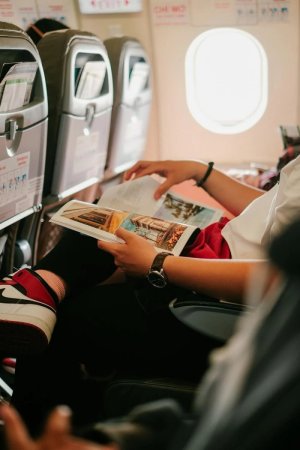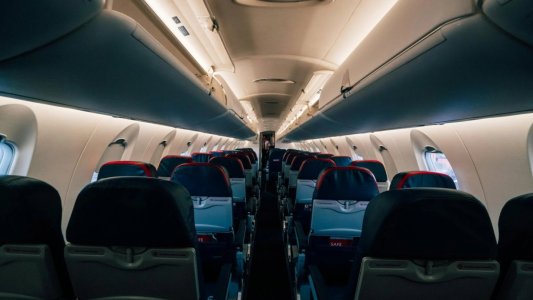Flight attendant insider: Discover the worst seat for avoiding sickness on a plane
By
Veronica E.
- Replies 0
When it comes to flying, most of us think about seat choices in terms of legroom, quick access to the restroom, or maybe snagging that coveted window view.
But for travelers who’ve ever felt woozy mid-air—or want to avoid it at all costs—the seat you pick can actually make all the difference in how you feel during the flight.
Thankfully, a seasoned flight attendant has pulled back the curtain on what many travelers overlook: the sneaky ways your seat can affect your comfort, especially if you're sensitive to motion.
And no, it’s not just about avoiding the middle seat.

The turbulence trap: Why the back of the plane is a no-go
Ever wondered why the back of the plane feels bumpier?
It’s not just in your head.
According to a British Airways flight attendant with seven years of experience, the rear of the aircraft is where turbulence tends to be strongest—and that’s not great news for anyone hoping to keep their stomach settled.
If you’re prone to motion sickness, this area might be one to skip.
So, where should you sit instead? The sweet spot is near the center of the aircraft, close to the wings.
This area is the plane’s center of gravity, making it more stable and less likely to feel those uncomfortable jolts and dips.
Also read: Discover the hidden safety secrets of airplanes: 6 mysterious features that could save your life
Aisle seat advantage: Easing anxiety and claustrophobia
There’s more to comfort than turbulence, though.
If you feel uneasy being boxed in or too close to the window, the aisle seat may be your best friend.
It gives you the freedom to move around, stretch, or take a quick walk without having to disturb others—which is a big plus if you're trying to stay calm and relaxed during your flight.
The aisle seat is also a top pick for travelers who get a little anxious or claustrophobic.
Being able to get up when needed—or just knowing that you can—can make all the difference in feeling at ease.

Also read: Airlines might hide fees from you—how this court ruling might affect your wallet
Airflow and distraction: Simple strategies to feel better
Small things can have a big impact.
The flight attendant also points out how keeping the overhead air vent on a steady, cool stream can help ease feelings of nausea.
It’s a detail many overlook, but it can really help keep motion sickness at bay.
And when it comes to in-flight entertainment, consider choosing options that don’t require staring at a screen too long.
Listening to music, a podcast, or an audiobook can be a gentler way to pass the time without triggering that unsettled feeling.
Dr. Danielle Qing, an internal medicine specialist, also recommends staying seated with your head down and eyes closed if you start to feel off.
Keeping your center of gravity low and minimizing visual stimulation can help reduce dizziness and nausea.
Also read: No means no: This passenger refused to give up their airplane seat to this child–Find out why!
The coveted fifth row: A sweet spot for travelers
One Virgin Australia flight attendant with ten years of experience has her own personal pick: row five.
According to Rosie Awad, this row tends to offer great views, extra legroom, and you’re often one of the first to be served.
Plus, it’s a convenient location for getting on and off the plane—without the added responsibilities of being in an emergency exit row.
However, she advises avoiding seats close to the restrooms or at the very back.
Noise, foot traffic, and unpleasant odors can make those areas less than ideal for a relaxing flight.
At the end of the day, choosing the right seat comes down to knowing your personal comfort zone.
If motion sickness is something you want to avoid, the middle of the plane, near the wings, and a good aisle seat might just be your winning combo.
And don’t forget the little things — air vents, movement, and mindful entertainment choices can all help make your flight more pleasant.
Read next: Toilet trouble at 30,000 feet—United pilot snaps over bathroom break!

Have you found a seat that works best for you? Do you have your own tricks for staying comfortable and avoiding that queasy feeling? We’d love to hear your tips and stories in the comments. Let’s help each other make every flight a little smoother!
But for travelers who’ve ever felt woozy mid-air—or want to avoid it at all costs—the seat you pick can actually make all the difference in how you feel during the flight.
Thankfully, a seasoned flight attendant has pulled back the curtain on what many travelers overlook: the sneaky ways your seat can affect your comfort, especially if you're sensitive to motion.
And no, it’s not just about avoiding the middle seat.

Choosing the right seat on a plane can make all the difference in avoiding motion sickness and ensuring a more comfortable flight. Image Source: Pexels / Pew Nguyen.
The turbulence trap: Why the back of the plane is a no-go
Ever wondered why the back of the plane feels bumpier?
It’s not just in your head.
According to a British Airways flight attendant with seven years of experience, the rear of the aircraft is where turbulence tends to be strongest—and that’s not great news for anyone hoping to keep their stomach settled.
If you’re prone to motion sickness, this area might be one to skip.
So, where should you sit instead? The sweet spot is near the center of the aircraft, close to the wings.
This area is the plane’s center of gravity, making it more stable and less likely to feel those uncomfortable jolts and dips.
Also read: Discover the hidden safety secrets of airplanes: 6 mysterious features that could save your life
Aisle seat advantage: Easing anxiety and claustrophobia
There’s more to comfort than turbulence, though.
If you feel uneasy being boxed in or too close to the window, the aisle seat may be your best friend.
It gives you the freedom to move around, stretch, or take a quick walk without having to disturb others—which is a big plus if you're trying to stay calm and relaxed during your flight.
The aisle seat is also a top pick for travelers who get a little anxious or claustrophobic.
Being able to get up when needed—or just knowing that you can—can make all the difference in feeling at ease.

Opting for an aisle seat can help reduce feelings of claustrophobia and make it easier to move around during the flight. Image Source: Pexels / Kelly.
Also read: Airlines might hide fees from you—how this court ruling might affect your wallet
Airflow and distraction: Simple strategies to feel better
Small things can have a big impact.
The flight attendant also points out how keeping the overhead air vent on a steady, cool stream can help ease feelings of nausea.
It’s a detail many overlook, but it can really help keep motion sickness at bay.
And when it comes to in-flight entertainment, consider choosing options that don’t require staring at a screen too long.
Listening to music, a podcast, or an audiobook can be a gentler way to pass the time without triggering that unsettled feeling.
Dr. Danielle Qing, an internal medicine specialist, also recommends staying seated with your head down and eyes closed if you start to feel off.
Keeping your center of gravity low and minimizing visual stimulation can help reduce dizziness and nausea.
Also read: No means no: This passenger refused to give up their airplane seat to this child–Find out why!
The coveted fifth row: A sweet spot for travelers
One Virgin Australia flight attendant with ten years of experience has her own personal pick: row five.
According to Rosie Awad, this row tends to offer great views, extra legroom, and you’re often one of the first to be served.
Plus, it’s a convenient location for getting on and off the plane—without the added responsibilities of being in an emergency exit row.
However, she advises avoiding seats close to the restrooms or at the very back.
Noise, foot traffic, and unpleasant odors can make those areas less than ideal for a relaxing flight.
At the end of the day, choosing the right seat comes down to knowing your personal comfort zone.
If motion sickness is something you want to avoid, the middle of the plane, near the wings, and a good aisle seat might just be your winning combo.
And don’t forget the little things — air vents, movement, and mindful entertainment choices can all help make your flight more pleasant.
Read next: Toilet trouble at 30,000 feet—United pilot snaps over bathroom break!
Key Takeaways
- Passengers prone to getting sick on flights should avoid sitting at the back of the plane due to increased turbulence.
- The best seats for avoiding motion sickness are in the middle of the cabin near the wings, with an aisle seat being preferable.
- Keeping the air vent on and staying seated with your head down can help manage airsickness during the flight.
- The fifth row on a plane is suggested as the best for views and convenience, while seats near lavatories or at the very back are regarded as the worst.
Have you found a seat that works best for you? Do you have your own tricks for staying comfortable and avoiding that queasy feeling? We’d love to hear your tips and stories in the comments. Let’s help each other make every flight a little smoother!





